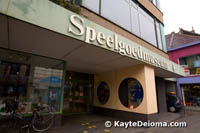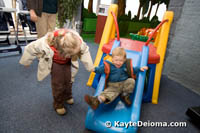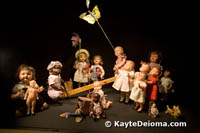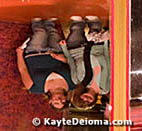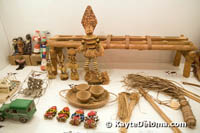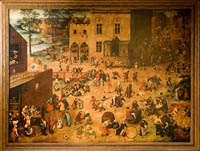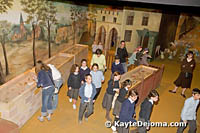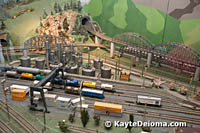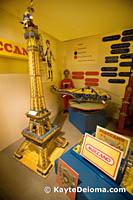story and photos by Kayte Deioma
Quad Cities is a very family friendly destination, with children’s programs or activities at most attractions. Even the hotel where we stayed at the Isle of Capri Casino had an indoor pool that was always packed with kids, and cribs were available for the room. But there are a couple places in the Quad Cities that are just kid heaven.
Family Museum
 For toddlers through pre-teens, the Family Museum in Bettendorf offers hands-on learning experiences that can keep youngsters entertained all day. My niece Becca, 9 and nephew Declan, 2, enjoyed their stay so much that we squeezed in a second visit before leaving town.
For toddlers through pre-teens, the Family Museum in Bettendorf offers hands-on learning experiences that can keep youngsters entertained all day. My niece Becca, 9 and nephew Declan, 2, enjoyed their stay so much that we squeezed in a second visit before leaving town.
 Making noise is always fun, so applying the mallets to xylophones made of different materials and banging on steel drums in a special sound-proof room in Rhythm Alley were perfect 2-year-old diversions that Becca also enjoyed.
Making noise is always fun, so applying the mallets to xylophones made of different materials and banging on steel drums in a special sound-proof room in Rhythm Alley were perfect 2-year-old diversions that Becca also enjoyed.
In the Amazing Acres exhibit, you can puff a cloud into existence, spin up a tornado or generate lighting in the weather display. Drive a John Deer combine through virtual corn fields; learn how farm goods become food at the market; groom and ride a stuffed horse, or fill up the car with bio-fuel. Our little squirrels enjoyed scampering up a giant tree trunk, and Declan became attached to a wooly sheep that was almost as big as he was.
 In Watts Up with Energy, see how hard you have to peddle a bicycle to generate enough energy to run a light bulb, a blender or a blow-dryer. The Energy Hog, a giant pig in a leather jacket, holds an interactive display that uses computer games to
In Watts Up with Energy, see how hard you have to peddle a bicycle to generate enough energy to run a light bulb, a blender or a blow-dryer. The Energy Hog, a giant pig in a leather jacket, holds an interactive display that uses computer games to teach lessons on saving energy around the house.
teach lessons on saving energy around the house.
The Human Body exhibit allows kids to assemble a skeleton like a puzzle from xrays of different bones, and try to insert all the organs in the right spaces in a plastic torso. A high-powered microscope gives a close up look at tiny blood cells; while a giant model of a heart lets you walk right through its chambers.
There’s a special play area called the Garden where parents can let toddlers loose to climb and explore. The gift shop is full of learning-inspired toys, and if you need a lunch break, there’s a café in the Library next door.
Michael’s Fun World
 For kids 5 through teens and adults, another great option is Michael’s Fun World. This was Becca’s favorite stop on our trip. Outdoors, Michael’s has a go kart track and miniature golf course, but on a rainy day you’ll want to head for the indoor fun.
For kids 5 through teens and adults, another great option is Michael’s Fun World. This was Becca’s favorite stop on our trip. Outdoors, Michael’s has a go kart track and miniature golf course, but on a rainy day you’ll want to head for the indoor fun.
The main warehouse-size building is filled with inflated play areas with competitive games like trampoline basketball and jousting. There’s even an air-filled obstacle course for two. Of course there’s one just for bouncing that requires no skill at all, just socks.
 A climbing, sliding playground that rises three stories into the rafters, a rock climbing wall and the inflatables are all included in the price of admission. There’s also a full arcade with video games, simulators, skill games and a couple lanes of Bowlingo requiring the purchase of tokens.
A climbing, sliding playground that rises three stories into the rafters, a rock climbing wall and the inflatables are all included in the price of admission. There’s also a full arcade with video games, simulators, skill games and a couple lanes of Bowlingo requiring the purchase of tokens.
 For hunters and warriors, there’s a separate room and a separate fee for laser tag. Wearing glow-in-the-dark green and orange vests, two teams face off against each other in a dark room, skulking among pseudo-structures to shoot the enemy’s vests and disable their lasers. They aren’t’ finished for good; they just have to recharge before getting back in the game.
For hunters and warriors, there’s a separate room and a separate fee for laser tag. Wearing glow-in-the-dark green and orange vests, two teams face off against each other in a dark room, skulking among pseudo-structures to shoot the enemy’s vests and disable their lasers. They aren’t’ finished for good; they just have to recharge before getting back in the game.
A separate building holds the baseball and softball batting cages with automatic pitching machines.
Family Museum
2900 Learning Campus Drive
Bettendorf, IA 52722
(563) 344-4106
www.familymuseum.org
Michael’s Fun World
345 West 76th Street
Davenport, IA 52806
(563) 386-3826
www.michaelsfunworld.com
?

 “If you build it, they will come” said a ghostly voice in the movie Field of Dreams. I can picture this same voice whispering to Frederick Braun when he came up with the idea to build the world’s biggest model train display. He convinced his more practical twin, Gerrit, that the project was feasible, and they set about putting together the funding and the team to make it happen. Now visitors are lining up to see the fantasy world they have created at Miniatur Wundurland.
“If you build it, they will come” said a ghostly voice in the movie Field of Dreams. I can picture this same voice whispering to Frederick Braun when he came up with the idea to build the world’s biggest model train display. He convinced his more practical twin, Gerrit, that the project was feasible, and they set about putting together the funding and the team to make it happen. Now visitors are lining up to see the fantasy world they have created at Miniatur Wundurland. Since 2001, this ever-expanding project has occupied a warehouse in the Speicherstadt district in Hamburg, Germany. Starting with 975 square feet of tableaus representing areas of southern Germany and the Austrian Alps, the exhibit has more than tripled in size to over 3700 square feet with the addition of Hamburg, Scandinavia, and America, and the latest creation, a multi-story model of Switzerland.
Since 2001, this ever-expanding project has occupied a warehouse in the Speicherstadt district in Hamburg, Germany. Starting with 975 square feet of tableaus representing areas of southern Germany and the Austrian Alps, the exhibit has more than tripled in size to over 3700 square feet with the addition of Hamburg, Scandinavia, and America, and the latest creation, a multi-story model of Switzerland. Loving detail has gone into recreating Hamburg, from the Town Hall to Landungsbrucken and St. Michael’s Church to the red light district of the Reeperbahn, to the thousands of mini fans packing the AOL Arena for an HSV soccer game. Ships and tour boats navigate real water in the harbor, while dozens of trains make their way through the Hamburg Main Train Station and subways stop at Baumwall, where a crowd has gathered for a techno music parade. Elephants cavort in the Hagenbeck Zoo; fire crews respond to a building fire; bikers race across the Kohlbrand Bridge; trucks load their wares in the Speicherstadt, tourists line up to get into the Dungeon, and daily life goes on in suburbs. Hollywood’s best model makers couldn’t have done any better.
Loving detail has gone into recreating Hamburg, from the Town Hall to Landungsbrucken and St. Michael’s Church to the red light district of the Reeperbahn, to the thousands of mini fans packing the AOL Arena for an HSV soccer game. Ships and tour boats navigate real water in the harbor, while dozens of trains make their way through the Hamburg Main Train Station and subways stop at Baumwall, where a crowd has gathered for a techno music parade. Elephants cavort in the Hagenbeck Zoo; fire crews respond to a building fire; bikers race across the Kohlbrand Bridge; trucks load their wares in the Speicherstadt, tourists line up to get into the Dungeon, and daily life goes on in suburbs. Hollywood’s best model makers couldn’t have done any better. America is about 1/3 the size of Hamburg. Las Vegas is well represented with landmark buildings like the MGM Grand, Luxor and Paris Las Vegas that light up when night falls, which is every 15 minutes at Miniatur Wunderland. In addition to the many cars and trucks moving through the streets and the monorail on the Strip, you get a view of the passenger and cargo trains making their way across the desert and through the Vegas railroad station, that most real life visitors would never see.
America is about 1/3 the size of Hamburg. Las Vegas is well represented with landmark buildings like the MGM Grand, Luxor and Paris Las Vegas that light up when night falls, which is every 15 minutes at Miniatur Wunderland. In addition to the many cars and trucks moving through the streets and the monorail on the Strip, you get a view of the passenger and cargo trains making their way across the desert and through the Vegas railroad station, that most real life visitors would never see. Adjacent to Las Vegas, Mount Rushmore and the Grand Canyon are in close proximity to each other with mining towns, Indian pueblos and Area 51 in between, all connected by trestle railroad bridges and a freeway system full of semis and tanker trucks. Amtrak delivers passengers to nearby Miami Beach, with its Art Deco architecture and palm trees. Cape Canaveral, the Everglades and Key West fill in the rest of Florida.
Adjacent to Las Vegas, Mount Rushmore and the Grand Canyon are in close proximity to each other with mining towns, Indian pueblos and Area 51 in between, all connected by trestle railroad bridges and a freeway system full of semis and tanker trucks. Amtrak delivers passengers to nearby Miami Beach, with its Art Deco architecture and palm trees. Cape Canaveral, the Everglades and Key West fill in the rest of Florida. Switzerland, which opened in November 2007 is the first multi-level exhibit, covering over 800 square feet. The Matterhorn rises from the third to the fourth floor of the building through an opening in the ceiling. You can follow the trains up the mountain via a stairway or look down on the scene from the railing above. Other things going on in the Swiss scene include a renaissance fair with knights competing in a joust near the foot of Castello di Montebello, workers making chocolate bars at the Lindt & Sprungli factory, and 20,000 fans camped out at a DJ Bobo concert, complete with requisite port-a-potties.
Switzerland, which opened in November 2007 is the first multi-level exhibit, covering over 800 square feet. The Matterhorn rises from the third to the fourth floor of the building through an opening in the ceiling. You can follow the trains up the mountain via a stairway or look down on the scene from the railing above. Other things going on in the Swiss scene include a renaissance fair with knights competing in a joust near the foot of Castello di Montebello, workers making chocolate bars at the Lindt & Sprungli factory, and 20,000 fans camped out at a DJ Bobo concert, complete with requisite port-a-potties. There is so much incredible detail to the models at Miniatur Wunderland that you could spend all day and not see everything. If you take just long enough to see the daylight and nighttime version of each set, you need a minimum of two hours, even for a superficial view. If you have kids along, you should allow plenty of time for them to push
There is so much incredible detail to the models at Miniatur Wunderland that you could spend all day and not see everything. If you take just long enough to see the daylight and nighttime version of each set, you need a minimum of two hours, even for a superficial view. If you have kids along, you should allow plenty of time for them to push  Behind the Scenes Tours let you see the inner workings of the systems and go behind the models to see where the trains go when they enter the tunnels. The tour goes through some pretty tight spaces, so size restrictions apply.
Behind the Scenes Tours let you see the inner workings of the systems and go behind the models to see where the trains go when they enter the tunnels. The tour goes through some pretty tight spaces, so size restrictions apply.